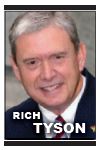Richard Tyson
Several years ago, I recommended Michael Gerber’s book, The E-Myth Revisited, to my clients. That led to discussion of the need for C-suite executives to understand what Gerber described as the difference between “In-the-Business” activities and “On-the-Business” activities. Working “in” your business is spending your time managing your company as it is today. Working “on” your business is investing time on your company as you want it to be in the future.
Both In-the-Business and On-the-Business activities are{mprestriction ids="1,3"} important, but especially in small, entrepreneurial businesses, the In-the-Business ones tend to take up most, if not all, of a leader’s time. Michael Gerber makes a strong case that it’s critical for leaders to carve out time for On-the- Business work.
What exactly constitutes such work? Clearly, it involves ongoing strategic thinking and planning. But how should this be done? Where should a small company leader begin?
A recent article in the Harvard Business Review, “The Ideas That Inspire Us,” shared the insights of Roz Brewer, the CEO of Walgreens. She shared that her best strategies have grown out of her visits to the Walgreens stores as she looks for ways to make them better. She listens to both their customers and the members of their teams. She stressed that “it’s best to see and hear feedback live and in person.”
From these visits, Brewer works with her store managers to develop proposals for innovative ideas to strengthen the Walgreens brand and their value proposition. She makes sure that those proposals are put in front of the people who will have to make them work. She asks, “Do we have this right? Endorse it or tear it apart, but tell me how this stacks up with your experience in the store.”
Brewer has literally taken her On-the-Business activities out of her office and into the lively real world of the Walgreens stores. She has encouraged her leadership team to do the same. This has exposed them to the real issues and challenges in the business so that they can effectively connect future strategy to the current operation. She has bridged the gap between In-the-Business and On-the- Business.
At one point in my career of coaching CEOs, I suggested to my clients that they do a personal time audit over a week or two to evaluate their personal effectiveness and efficiency. Upon completion of this process, one client, the CEO of a manufacturing firm, expressed deep concern with how he “routinely wasted time.” He shared that his typical day involved “wandering” through the floor of his production facility, where he chatted with a number of his employees. He said that over the course of a workweek, he wasted between five and 12 hours doing this.
I asked him what he and his employees chatted about, to which he responded that it was usually just how things were going in their families, and inquiring about things that were personal and important to them. He noted that he liked doing this, and that his employees seemed to appreciate his interest, but that he was sure he could use that time more wisely behind his desk.
I asked him if, in his chats, he ever discussed how their respective jobs were going and how things could be improved. He said that this certainly happened, but that this wasn’t his primary focus — and that he intended to stop his daily wandering through his plant.
I asked him not to make any drastic changes, but to share his thoughts with a group of his peers at our monthly CEO forum. He agreed, and a week later, we teed up the issue with the group.
A lively discussion led to this conclusion: His daily wandering and chats were clearly an investment, rather than an expense. He was showing that he cared for his people, and he was learning from them, first-hand, on how to improve their work. He was doing important On-the-Business work. The consensus by his peers was that each of them should adopt his process of regularly walking and talking with their teams.
Roz Brewer attributes much of Walgreens success to her store visits. Might such wandering help you with your essential On-the-Business responsibilities?
Richard Tyson is the founder, principal owner and president of CEObuilder, which provides forums for consulting and coaching to executives in small businesses.{/mprestriction}








